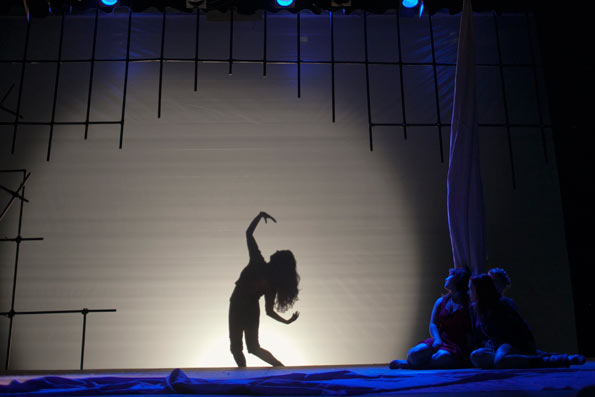Rock opera re-imaginings of Greek shadow delightfully experiments

By Peter Hernandez
The Guardsman
At City College’s Diego Rivera Theater, Barbara Martins stands writhing and shimmying on a platform behind a thin plastic curtain while a rock song reminiscent of Devo guides her convulsions. Martins is playing Iphigenia, the sacrificed 12-year-old daughter of King Agamemnon. Her death is the motivation for her mother, Clytemnestra, to seek vengeance and justice.
From the audience, she is seen as a 30-foot tall dancing shadow. Myles Wynn stands behind her, projecting a dramatic and over-sized hand that appears to be manipulating her from above.
They are rehearsing the Oresteia, a 2,500-year old trilogy of Greek tragedies — although the use of “shadow play” may have never been envisioned by its writer, Aeschylus.
“I think the shadow play is fantastic,” said Jesse Blanca, the video technician on stage. “You’re seeing 30-foot-tall people going at it with each other.”
City College theater instructor John Wilk’s rock opera re-imagining of the Greek classic is true to the themes of justice and sorrow, merging them with modern elements such as contemporary rock music and the use of projected clips of stock video like blooming flowers and setting suns.
“John was joking he’s like a mad scientist,” said Eric Iverson, the composer of the musical’s 12 songs.
Iverson takes inspiration from the original script, sometimes incorporating the text verbatim into his lyrics. “Where is the justice, where is the truth?” asks the complete chorus in the finale.
The composer, who was personally approached by Wilk, draws from punk rock, David Bowie, and in one song, a “noisey Sonic Youth” outro. These sonic experimentations complement the physicality of Wilk’s staging which includes a raked stage, placing the actors at a dramatic incline.
King Agamemnon, played by Carlos Hailey, returns to his palace home in Argos with his concubine Cassandra, played by Leota Tisdale-Rhodes. Agamemnon’s wife Clytemnestra, whose bitterness over her daugther’s sacrifice has been brooding, spirals into madness.
“She has so many different levels of emotion. She wants to take revenge and she becomes sick and twisted — she enjoys the release and the sensuality of preparing for murder,” said Amy Covell, who plays Clytemnestra.
“Oh to be murdered in this place, how will I escape this fate?” asks Cassandra, shortly before she is murdered by Clytemnestra to the accompaniment of the rock song “Red Rain,” a favorite among the cast.
The king is next to die.
“It’s a very feminist scene. The queen kills the husband and says, ‘Argos is mine’ — it gives me goosebumps every time,” said one of the Furies, played by Bruna Palmero, whose lasting presence on stage provides a twofold purpose — connecting otherwise dissonant scenes and tormenting Orestes, the son of Clytemnestra, when he returns to Argos to avenge his father.
The Furies’ make-up is described as “non-human” by make-up stylist, Alejandro Lionel-Mobley Suarez, whose technique aims for “Grecian meets Vogue editorial.” His make-up for Clytemnestra, the murderous wife of King Agamemnon, shifts throughout the musical, indicative of her character’s transitions.
“The queen looks really sculpted at the beginning, and as (she) spirals with madness, her hairstyle is disheveled,” adds Carolyn Reinholdt, hair stylist.
The costumes, designed by José Lieva maintain a modern approach to period looks — Agamemnon’s costume draws from King Louis the XIV, while Clytemnestra’s ornate floor-length nightgown follows a bronze and golden palette, complementing the actress’ bronze-orange hair. The image is that of regalness.
Wilk’s production of Oresteia presents a significant collaboration between many facets of the City College community. Tisdale-Rhodes’ mother contributes violin to one of Iverson’s songs.
Through the dizzying use of projection, experimentation, dance and song, Wilk ensures that the universality of the Oresteia story will continue.
“I wondered what would happen if a group of artists touched upon a modern and unusual tragedy,” said Wilk. “We won’t know until our performance.”

Comments are closed.